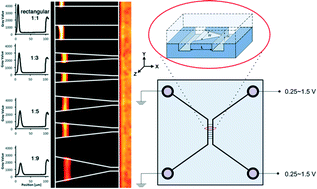Concentration gradient focusing and separation in a silica nanofluidic channel with a non-uniform electroosmotic flow†
Abstract
The simultaneous concentration gradient focusing and separation of proteins in a silica nanofluidic channel of various geometries is investigated experimentally and theoretically. Previous modelling of a similar device [Inglis et al., Angew. Chem. Int. Ed., 2011, 50, 7546] assumed a uniform velocity profile along the length of the nanochannel. Using detailed numerical analysis incorporating charge regulation and viscoelectric effects, we show that in reality the varying axial electric field and varying electric double layer thickness caused by the concentration gradient, induce a highly non-uniform velocity profile, fundamentally altering the protein trapping mechanism: the direction of the local electroosmotic flow reverses and two local vortices are formed near the centreline of the nanochannel at the low salt concentration end, enhancing trapping efficiency. Simulation results for yellow/red fluorescent protein R-PE concentration enhancement, peak focusing position and peak focusing width are in good agreement with experimental measurements, validating the model. The predicted separation of yellow/red (R-PE) from green (Dyl-Strep) fluorescent proteins mimics that from a previous experiment [Inglis et al., Angew. Chem. Int. Ed., 2011, 50, 7546] conducted in a slightly different geometry. The results will inform the design of new class of matrix-free particle focusing and separation devices.


 Please wait while we load your content...
Please wait while we load your content...